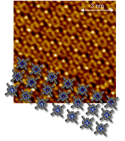 Nebraska MRSEC exploits the huge potential of molecular self-assembly on surfaces to form ordered 2D organics, as model systems for the study of the fundamental relationship between their structure and their physical properties. To this end, organic nano-architectures are engineered like Legos, molecule-by-molecule, to achieve desired functionality. Porphyrin molecules are of particular interest here because many different metal atoms can be inserted into the porphyrin ring, thus offering a wealth of possibilities to manipulate the structures and their properties. A key finding is that the delicate balance between molecule – molecule interactions and molecule – substrate interactions can be directed with the substrate, thereby allowing us to steer the self-assembled growth as well as to manipulate some of the key properties of the organic nanostructures. This research improves our current understanding of these organic nanomaterials with significant potential for application in molecular electronics, sensors, catalysts, actuators, and opto-electronics.
Nebraska MRSEC exploits the huge potential of molecular self-assembly on surfaces to form ordered 2D organics, as model systems for the study of the fundamental relationship between their structure and their physical properties. To this end, organic nano-architectures are engineered like Legos, molecule-by-molecule, to achieve desired functionality. Porphyrin molecules are of particular interest here because many different metal atoms can be inserted into the porphyrin ring, thus offering a wealth of possibilities to manipulate the structures and their properties. A key finding is that the delicate balance between molecule – molecule interactions and molecule – substrate interactions can be directed with the substrate, thereby allowing us to steer the self-assembled growth as well as to manipulate some of the key properties of the organic nanostructures. This research improves our current understanding of these organic nanomaterials with significant potential for application in molecular electronics, sensors, catalysts, actuators, and opto-electronics.
The STM image shows a surface-supported network of porphyrin molecules on Ag(111). Individual molecules that constitute the 2D molecular network are clearly visible. Model porphyrin molecules are superimposed, to show the arrangement of the molecules in the network. Image size: 10 nm x 10 nm.